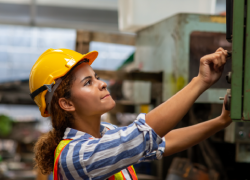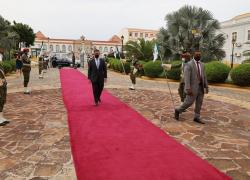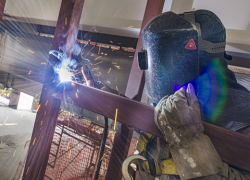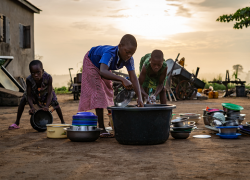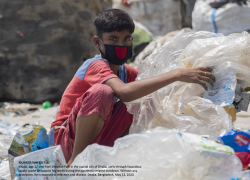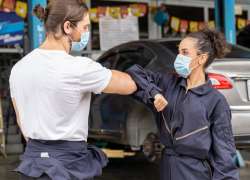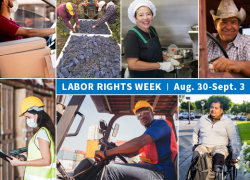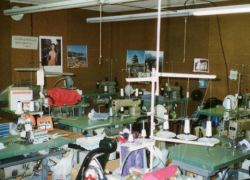Bureau of International Labor Affairs (ILAB)
Oct. 11 is International Day of the Girl. Girls comprise almost 40% of the 160 million child laborers in the world, according to the International Labor Organization, but much of girls’ work remains unseen and uncounted, such as the countless hours many girls spend at home doing household chores for no pay. It is also hard to estimate the number of girls in domestic work.
The U.S. Labor Department’s Bureau of International Labor Affairs (ILAB) is leading the U.S. government’s efforts to combat child labor and forced labor. We understand that girls experience the world of work differently from boys, including facing different risks on the job, such as physical risks and gender-based violence. We design our programs to be gender-responsive and to meet the unique needs of children of all genders.
Here are three things you likely didn’t know about the work of girls and what ILAB is doing about it.
1. The cocoa in your chocolate might be produced by girls in child labor.
Ghana is the second-largest supplier of cocoa to the global market, and in Ghana’s cocoa sector, girls make up almost half of the child laborers (43%). Ghanaian women and adolescent girls working in cocoa production and harvesting are often underpaid (earning about 30% less than their male counterparts) or simply unrecognized for their roles in cocoa production and harvesting.
What we’re doing: ILAB’s Adwuma Pa project, operated by CARE, is helping women and adolescent girls find better opportunities, whether within cocoa or in other work. The project offers literacy, numeracy, and skills development for girls engaged in child labor in Ghana’s cocoa sector across 80 cocoa-producing communities. The project also supports women and girls with vocational training, and helps combat poverty with savings, loan and mentorship programs. The project is working with a large cocoa company, Olam Ghana, to improve their labor practices to reduce child labor, address gender inequities and other labor rights violations, and create policies that advance the rights of women and girls working in the cocoa supply chain. For every three chocolate bars consumed in the world, one is made from cocoa beans supplied through Olam.
2. Girls working in agriculture are at risk of physical harm and gender-based violence.
Women and girls in unsafe working conditions in agriculture are frequently targets of gender-based violence or sexual harassment, according to UN Women. Agricultural work also poses significant physical risk for girls carrying heavy loads and using repetitive motions, working outside at all hours and at heights, using dangerous tools and equipment, and being exposed to pesticides and agrochemicals that can harm their reproductive health.
What we’re doing: ILAB’s programs in Mexico and Colombia help address these risks holistically, recognizing the links between social, psychological, political and economic empowerment. The EQUAL Project in Mexico, implemented by World Vision and Verité, works in collaboration with the Government of Mexico to address gender disparities in the sugarcane and coffee sectors. In Colombia, the Vamos Tejiendo project, implemented by Pact, works to do the same in the cut flower and panela – or unrefined whole cane sugar – sectors. The projects are bringing together public and private sector allies to tackle the poverty and discrimination that contribute to girls’ child labor, including addressing safety risks of exposure to agrochemicals.
3. Women’s entrepreneurship programs can do more harm than good to girls’ child labor outcomes.
Girls can suffer when programs to help women increase their earnings don’t take into account the risk of increasing child labor. A recent report commissioned by ILAB to better understand the intersection of child labor, working conditions for women and women’s empowerment initiatives suggests that, in many cases, women entrepreneurs struggle to manage the additional work involved in growing a bigger business while also needing to take care of household tasks. Too often, they turn to those closest to them for help — their children. Girls are often the first ones to be kept home from school to help with the growing demands of a new family business. In fact, all told, as of 2019, UNICEF estimated that 129 million girls were out of school worldwide. That number has likely increased during the COVID-19 pandemic.
What we’re doing: To support women entrepreneurs to make decisions with optimal outcomes for children, women’s entrepreneurship programs and micro-lenders need tools that can influence these behaviors. ILAB’s Reducing Incidence of Child labor and Harmful Conditions of Work in Economic Strengthening Initiatives (RICHES) Project is developing tools for policymakers and service providers covering a range of topics - diagnosing unsafe working conditions, accessing community resources, and more. With these tools, they can support women entrepreneurs in increasing their incomes while also complying with laws that protect children and promote acceptable work conditions, even in very small businesses. Currently in the pilot stage, we aim to make these tools available globally, helping more women to grow their enterprises and keep their girls out of harm’s way.
Learn more about the Bureau of International Labor Affairs’ global projects here: https://www.dol.gov/agencies/ilab/projects
Thea Lee is the deputy undersecretary for international affairs. Follow ILAB on Twitter at @ILAB_DOL.

 U.S. Department of Labor Blog
U.S. Department of Labor Blog
